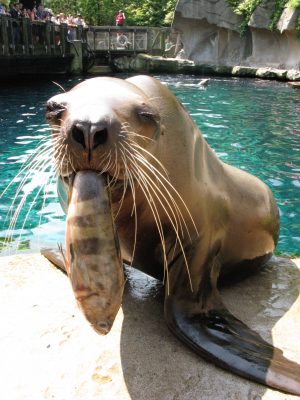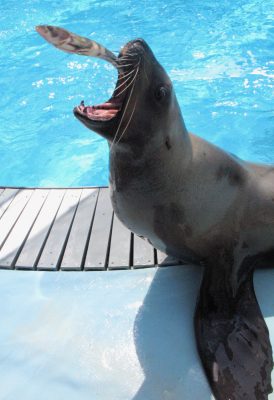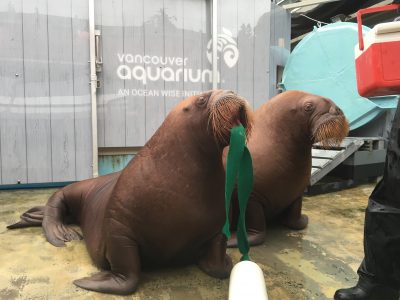If we want to conserve wild animals we need numbers — specifically, we need hard data that can go into models that tell us how much environmental change a species can tolerate before its survival is threatened.

Atka, the Steller sea lion having a snack as part of training. ©David Rosen
David Rosen, an assistant professor at UBC’s Institute for the Oceans and Fisheries (IOF), worked with trainers and caretakers at the Vancouver Aquarium to find some crucial numbers for two species of pinniped: Steller sea lions and walruses.

Ashby, the Steller sea lion grabbing a snack. ©David Rosen
Rosen credits the long-term partnership between the UBC Marine Mammal Research Unit and the Vancouver Aquarium for giving him continued access to sea lions and walruses in order to obtain the data for these models. For example, by examining the record of changes in the Steller sea lions’ diets and the corresponding fluctuations in their weight and growth, Rosen created a formula that could predict how much energy the animals need to consume daily to grow at a steady rate, and how quickly their growth would decline if their energy needs aren’t met.
“Everyone knows if you eat less it’s going to decrease your weight,” Rosen said. “But in the case of Steller sea lions, what numbers do we actually put in the model? How is food restriction truly going to affect the physiology, the individual health, the individual body mass? Now we have a really good understanding of what numbers to put in that model.”
He hopes that this discovery will help researchers better understand the threats facing Steller sea lions, as some populations have declined as much as 85 per cent, possibly due to changes in food availability.

Young walruses, Balzac and Lakina, at the Vancouver Aquarium ©David Rosen
Rosen and trainers at the Vancouver Aquarium taught two juvenile walruses to rest inside a floating Plexiglas dome that measured how much oxygen they consumed (short video at bottom of page). The goal was to get a measure of the animals’ resting metabolic rate (RMR)— the number of calories the body uses while resting. They also measured the amount of energy they used while swimming, by teaching the walruses to swim laps of their large research pool. It turns out that although walruses use less energy than expected while resting, that small savings is overshadowed by the large amount of energy they expend swimming.

Walrus resting inside a floating Plexiglas dome ©David Rosen
“If we have a choice between two scenarios, we can now predict what is going have the greatest effect on these individual animals,” Rosen said. “For example, if we have to do something in the environment, such as industrial development or establishing wind farms— this helps us determine the times of year and the areas where building something will have less impact.”
“It’s not just a question of whether something we do will be bad for animals. We can usually make a good guess there. This tells us how bad things are going to be and gives us an opportunity to change what we’re doing to minimize the impact.”
The studies “The effect of food restriction on growth rates in Steller sea lions, Eumetopias jubatus” and “Resting and swimming metabolic rates in juvenile walruses (Odobenus rosmarus)” were recently published in Marine Mammal Science.
By Riley Tjosvold
A short video, narrated by Dr. David Rosen, illustrating the oxygen test.
Tags: David Rosen, faculty, marine mammals, MMean Lab, pinnipeds, Research, sea lions, Vancouver, walrus